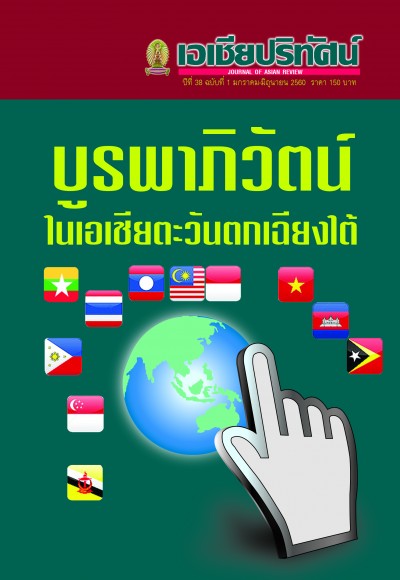Thai Labor Force in Malaysia: Employment Status, Labor Protection, and Victims of Human Trafficking
Main Article Content
Abstract
As a country in the Southeast Asian region, Malaysia has many Thai migrant workers, who have gone to work there, as well as in some other countries such as Singapore. This is because Malaysia has suffered a labour shortage in several sectors. In the case of those going to work in Malaysia, two types of them can be distinguished, namely, those going to work legally and those going to work illegally. Malaysia has developed a system for those going to work there legally, i.e. Foreign Workers Centralized Management System (FWCMS). This is the system which imports labour into Malaysia legally. Most Thai workers going to work in Malaysia illegally use passports stamped with tourist visas or border passes obtained in the three southernmost provinces of Thailand. Following their entry into Malaysia, they will be smuggled into an inner area of the country. How they get there depends on their contacts with relatives, family connections, and brokers, who take them to the firms or workplaces. There are sectors which are allowed by the Malaysian government to employ foreign workers legally; these include the construction, agricultural and certain service sectors, including the massage and household services. The sectors in which Thai workers have been smuggled to work include the restaurant (waiter) and Thai massage services, construction, sea fishery and agriculture in the border areas. With regard to labour protection, if Thai workers go to work legally, they will be protected by labour law of Malaysia, but if they go to work illegally, they will not receive any labour protection in this country. In this case, if they are arrested, they will be prosecuted and deported. There are victims of forced labour, mostly those who have been smuggled to work illegally. They are thus exploited by employers who provide them with low wages, seize their passports, or force them into prostitution especially in the massage sector. However, in the case of Thai workers being deprived of labour rights or becoming victims of exploitation or victims of human trafficking, there exist Thai agencies, with which those who have fallen victim to exploitation can lodge complaints. These agencies include the Royal Thai Embassy in Kuala Lumpur and Thai labour office in Malaysia, which will assist Thai workers.
Article Details
References
2. วิเชียร กัณฐตุริต. 2553. แนวทางการช่วยเหลือแรงงานในจังหวัดชายแดนภาคใต้เพื่อการมีงานทำ : กรณีศึกษาแรงงานร้านอาหาร (ต้มยำ) ในมาเลเซีย. กรุงเทพฯ: ศูนย์อำนวยการบริหารจังหวัดชายแดนภาคใต้ สำนักงานปลัดกระทรวงแรงงาน.
3. สมาน เหล่าดำรงชัย. 2557. ปัญหาการย้ายถิ่นของประชากรในกลุ่มประเทศอาเซียนที่มีผลกระทบด้านความมั่นคง. กรุงเทพฯ: ศูนย์วิจัยการย้ายถิ่นแห่งเอเชีย สถาบันเอเชียศึกษา จุฬาลงกรณ์มหาวิทยาลัย.
4. สำนักงานแรงงานไทยในประเทศมาเลเซีย. 2559. “ทางการมาเลเซียประกาศใช้ระบบ FWCMS.” เข้าถึงเมื่อ. 25 เมษายน 2559. http://malaysia.mol.go.th/node/586.
5. สำนักงานบริหารแรงงานไทยไปต่างประเทศ. 2559. “สถิติจำนวนแรงงานไทยที่ได้รับอนุญาตเดินทางไปทำงานต่างประเทศ.” เข้าถึงเมื่อ 2 พฤษภาคม 2559 http://www.overseas.doe.go.th.
6. สำนักงานแรงงานในประเทศมาเลเซีย. 2559. “สถานการณ์แรงงานไทยในเมาเลเซีย.” เข้าถึงเมื่อ. 25 เมษายน 2559. http://malaysia.mol.go.th/node/357.
7. สำนักงานแรงงานในประเทศมาเลเซีย. 2559. “แนวโน้มและโอกาสของแรงงานไทย.” เข้าถึงเมื่อ. 21 เมษายน 2559. http://malaysia.mol.go.th/trends_opportunities.
8. สุทธิพร บุญมาก. 2556. “การส่งเงินกลับบ้าน: แรงงานไทยเชื้อสายมลายูในประเทศมาเลเซีย.” วารสารปาริชาติ 26 (1):
74 – 93.
ภาษาอังกฤษ
1. Department of Fisheries Malaysia. 2014. “Annual Fisheries Statistics.” Accessed February 20, 2016. http://www.dof.gov.my/en/perangkaan-perikanan-jilid.
2. Department of Immigration Malaysia. 2013. “Unskilled Foreign workers who allow to work in Malaysia.” 1 July. Accessed June 11, 2559. http://www.main-services/foreign-worker.
3. Piper, Nicolar. 2013. Migrant Labor in Southeast Asia. 22. Singapore: Friedrich -Ebert –
Stiftung.


